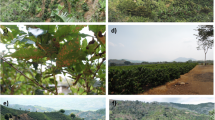Abstract
Arenga pinnata is the most important sugar palm of the humid tropics. Besides yielding sugar, it provides a great number of products and benefits to its users, and is one of the most diverse multipurpose tree species in culture.
The various ways in which this palm is used are illustrated for the native population of four Indonesian provinces. Although all people make use of the palm, the intensity of use, and the products which are used, vary widely among places. The peoples of East Kalimantan where there is a very low population density and a Muslim population, makes relatively little use of the palm. The peoples of North Sumatra, with a mostly Christian population, and of West Java, with a very high population density make intensive use of the sugar palm. The most advanced cropping and cultivation patterns have developed in North Sulawesi, where many old traditions are based on sugar palm cultivation.
The potentials of A. pinnata in cropping systems including agroforestry are presented. Prerequisites for intensified cultivation are discussed.
Similar content being viewed by others
References
Bastaman DD (1985) Pengaruh beberapa macam perlakuan terhanap perkecambahan benih aren (Arenga pinnata) (Wurmb) Merr Unpubl. Saviour of Arjana Thesis, UNPAD Bandung. 77 pp
Clement CR (1989) The potential use of the Pejibaye palm in agroforestry systems. Agroforestry Systems 7(3): 201–212
Dransfield J and Mogea JP (1984) The flowering behaviour of Arenga (Palmae: Caryotoideae). Bot J Linn Soc 88: 1–10
Flach M and Schuiling DL (1989) Revival of an ancient starch crop: a review of the agronomy of the sago palm. Agroforestry systems 7(3): 259–281
Fox JJ (1977) Harvest of the Palm. Harvard Univ Press (Cambridge, Mass.). 290 p
FPRDC Agency (1989) Socio-economic studies on aren utilization and assessment of the basic properties of its wood. Annual report, Mineograph, Bogor. 21 pp
Hamilton LS and Murphy DH (1988) Use and management of nipa palm (Nypa fruticans, Arecaceae): a review. Economic Botany 42(2): 206–213
Heyne K (1950) De Nuttige Planten van Indonesie ed. 3, 1. 383–389. 's-Gravenhage
Johnson DV (1983) Multipurpose palms in agroforestry: a classification and assessment. Int'l Tree Crops J 2: 217–244
Kartawinata K. Unesco Regional Office, Jl. Thamrin 14, Jakarta, Indonesia (personal communication)
Lorenz C and Priyono R (1986) Kemungkinan pengembangan tanaman aren (Arenga pinnata) di daerah tepi sungi, Wilayah Mahakam Tengah, Kabupaten Kutai, Kalimantan Timur. MS prepared for the Workshop on Integrated Riverbank Farming Systems, Kota Bangun, 8–12 November 1986. TAD, Samarinda, Indonesia
Maydell HJ von and Götz E (1985) Palmen in agroforstlichen Landnutzungssystemen der Sahel — und Sudanzone. Mitt. BFH Hamburg,148,Beitr. z. Weltforstwirtschaft (World forestry miscellanea) V: 41–143
Miller RH (1964) The versatile sugar palm. Principes 8(4): 115–147
Mogea JP (1980) Morfologi perbandingan perkecambahan beberapa jenis Palmae. Makalah Seminar Biologi Nasional Ke-4. Bandung, Mimeograph. 10 pp
Nair PKR (1979) Intensive multiple cropping with coconuts in India. Principles, programmes and prospects. Berlin and Hamburg: Verlag Paul Parey. 147 pp (= Fortschritte im Acker — und Pflanzenbau. Beih Z Acker — u. Pflanzenbau, 6)
Nurstiyono E (1986) Studi tentang potensi dan pemasaran gula aren (Arenga pinnata) di keluruhan Sei. Pinang Dalam, Kecamatan Samarinda Ilir. Unpubl. Sl-thesis, Mulawarman University, Agriculture Faculty, Samarinda, Indonesia
PC.R (1981) SOS untuk Aren. Trubus 12 (140): 304–305
Sadyawati Y (1985) Analisis usaha pengrajin gula merah di Temindung. Unpubl. Sl-thesis, Facultas Ekonomi, Universitas Mulawarman, Samarinda. 80 pp
Smits WTM (1988) ARenga pinnata (Wurmb) Merr. pp 505–55. In: Westphal E and Jansens PCM (eds.) 1989. PROSEA — Plant Resources of South-East-Asia. A selection, Pudoc, Wageningen. 322 pp
Sumarni (1987a) Ijuk, hasil sampingan yang mengundang devisa. Trubus 18 (207): 100–101
Sumarni (1987b) Menyiapkan ijuk untuk ekspor. Trubus 18 (207): 100–102
Tammes PML (1933) Observations on the bleeding of palm trees. 514–536. In: Recueil des Travaux Botaniques Néerlandais, V. 30
Uhl NW and Dransfield J (1987) Genera Palmarum. Kansas. 610 pp
Vries H (1853) Reinwardt's Reizen naar Nederlands Oost-Indië. 729 pp
Author information
Authors and Affiliations
Rights and permissions
About this article
Cite this article
Mogea, J., Seibert, B. & Smits, W. Multipurpose palms: the sugar palm (Arenga pinnata (Wurmb) Merr.). Agroforest Syst 13, 111–129 (1991). https://doi.org/10.1007/BF00140236
Issue Date:
DOI: https://doi.org/10.1007/BF00140236




